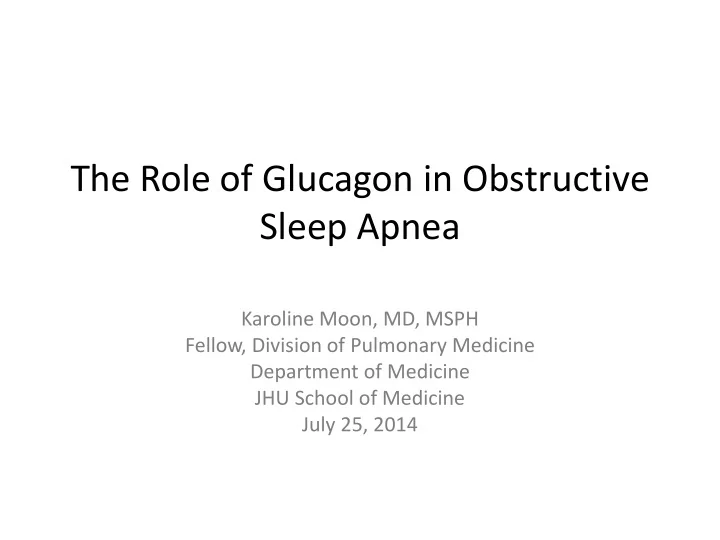

The Role of Glucagon in Obstructive Sleep Apnea Karoline Moon, MD, MSPH Fellow, Division of Pulmonary Medicine Department of Medicine JHU School of Medicine July 25, 2014
Background • Obstructive sleep apnea – Characterized by intermittent hypoxia – Associated with diabetes and dysglycemia independent of obesity • Intermittent hypoxia associated with higher fasting glucose in animal and healthy human studies • Hepatic glucose output controls fasting glucose and is regulated by multiple factors including: – glucagon, catecholamines, insulin, and free fatty acids • Catecholamines are known to be elevated in OSA • Whether glucagon levels are higher in persons with vs. those without OSA is unknown
Conceptual Model Obstructive Sleep Apnea Intermittent Hypoxia Systemic Inflammation Sympathetic Nervous Adipo-Cytokines System Activity Oxidative Stress Type 2 Diabetes
Glucagon and Fasting Glucose Low Blood Sugar Glucagon Liver Hepatic Glucose Output Raises Blood Sugar
Hypotheses • Fasting glucagon is higher in patients with vs. those without OSA • Fasting glucagon accounts for some of the elevation in fasting glucose observed in patients with OSA
Study Population • Cross sectional study • Males, 65 years or older recruited as part of larger trial of osteoporosis (MrOS Sleep Study) • Plasma samples from 118 participants available at Johns Hopkins • Exclusions: Patients with history of diabetes or incomplete overnight polysomnography (PSG)
Enrollment from 6 US clinical centers (n=3,135) Standardized Polysomnogram Protocol + Fasting blood sample morning after PSG, plasma separated and stored at -80°C (n=2,604) emerysleepcenter.com Plasma samples available at Johns Hopkins (n=118) Exclude samples with history of diabetes Measure glucagon levels with commercially available kit (Millipore Glucagon ELISA)
Analysis • Primary dependent variable: fasting plasma glucagon • Secondary dependent variable: fasting plasma glucose • Independent variables (separate models): – OSA status – Severity of OSA by Apnea-Hypopnea Index (AHI) – Metrics of hypoxic stress: average oxygen saturation during sleep, frequency of oxygen desaturation, proportion of sleep time below oxygen saturation 90% • Separate multivariable generalized linear models (GLM) for glucagon and fasting glucose to determine association with OSA and its severity • Multivariate GLM for glucagon with fasting glucose as an independent variable (mediation analysis) • Covariate adjustment for age, race, BMI
Significance • We expect that worsening OSA will be associated with increases in both fasting glucose and glucagon levels • If glucagon levels are elevated in OSA, glucagon signaling may be a potential therapeutic target • Lack of an association of glucagon levels with OSA would suggest that other mechanisms for derangement of fasting glucose in OSA should continue to be explored
Questions?
Recommend
More recommend